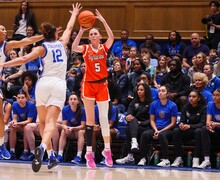Exhibition gives voice to students
Walking through the unassuming halls of Syracuse University’s Hoople Special Education Building, one wouldn’t expect to find much of interest. Yet displayed on the first floor hallway walls are photographs and poems that, upon consideration, reveal the thoughts and personal experiences of college students with disabilities. Whether the Braille cards with explanatory notes or the photos themselves catch the eye, PhotoVoice: Changing the Image of Disabilities — Reflections and Resolutions portrays a perspective that often goes unnoticed.
‘Most people don’t think about college students with disabilities,’ said Wendy Harbour, Lawrence B. Taishoff Professor for Inclusive Education in the School of Education.
Through PhotoVoice, people are given the opportunity to think about disability in a way that’s interactive and engaging, she said.
Harbour, also the executive director of the Taishoff Center for Inclusive Higher Education, first saw PhotoVoice while at an Association on Higher Education and Disability conference in Seattle in July 2011.
She was intrigued by the exhibit and arranged for it to be displayed at the Disabled and Proud conference, held in August 2011 at SU. The conference was planned by and for college students with disabilities, and it brought together student leaders to discuss disability in higher education, according to the Disabled and Proud website.
Displaying PhotoVoice at the conference allowed its participants to see art by other college students, Harbour said. The exhibit was so well received that Harbour asked to keep the display at SU through the fall 2011 semester.
The images on display in the Hoople building reflect a variety of different disabilities and viewpoints of students from Michigan, Missouri and South Carolina. One photograph by a student with vision impairment portrays an out-of-focus coffee shop menu. The note accompanying this photograph describes how the student often tells his friends he is not hungry when they are ordering food because it is difficult to read the menu. One set of photos captures how a handicapped parking spot was removed to make room for dumpsters. Another shows a sign that reads, ‘Elevator is out of order, but the stairs work just fine.’
‘It’s fun — and interesting — to see how college students choose to talk about their disabilities,’ Harbour said. ‘Some focus on the law, others talk about identity.’
The PhotoVoice projectfor college students with disabilitiesbegan at the University of South Carolina and Eastern Michigan University. Since then, more than a dozen other colleges and universities have participated in the project. At each school, students worked together to create an exhibit of photography and poems to express their feelings about living with disabilities.
PhotoVoice puts disability on the radar for anyone who happens to see it, whether or not they know or are connected to anyone with a disability, Harbour said.
Art can be a valuable tool for discussing disability, Harbour said. And while the photographs now on display are not by SU students, the Taishoff Center is working to have its students contribute to PhotoVoice. A PhotoVoice book is also a potential project, Harbour said.
‘It’s exciting to think that SU could have a part in expanding PhotoVoice.’
One gallery viewer,Rachel Romer, saw PhotoVoice while visiting the Hoople building. As president of Self-Advocacy for Change, an organization that brings people with disabilities together to initiate change, she has seen a number of PhotoVoice exhibits at other schools and events.
‘It brings people to realize that people with disabilities have voices,’ Romer said.
Published on September 26, 2011 at 12:00 pm
Contact Ian: insimonc@syr.edu





